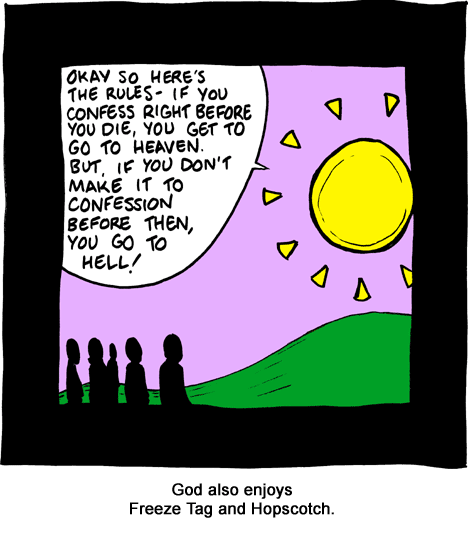(I originally posted this back in 2010 or so on the since-vanished Mormon Mentality blog. In 2013, a friend asked me about thoughts on grace, so I ended up reposting it here. I’ve made a few minor edits since then, removing a link that no longer resolves and clarifying one statement.)
[From 2010]: I’m still not sure what triggered this thought (and associated mental images), but I’m pretty sure it happened while listening to random (audio) chapters from the Book of Mormon on my iPhone (that’s the bulk of my scripture study these days — that and random audio chapters from the New Testament).
Let me start with a story I’ve told before (so if you’ve heard it before, apologies). A bit less than 30 years ago, I was visiting Utah from out of state and attended church with an acquaintance of mine. Said acquaintance had a PhD from the Ivy League, of which he was quite proud, and was at that time teaching at BYU; we attended his ward in Orem. Though I was not at that time a high priest, I attended high priest group meeting with him. When it was over, and we were walking back to his home from the chapel (this is Orem, after all), he said something to the effect of: “You know, I look around the high priest group, and I see men such as myself and [named a few others], all with PhDs and academic positions; and I also see 3rd- and 4th-generation farmers who never got beyond high school; and I marvel that the same church and gospel can encompass both.” To which I replied, “Maybe from where God sits, there isn’t any real difference.” He was not amused.
In the years since then, I have continued to dwell on that concept: that in most areas that we discern differences, the Lord sees few, if any. That’s why I smile when I hear the common dismissal of Abrahamic religion as “the local god of some wandering nomads.” We tend to be snobs of space, time, culture, education and wealth — what could we have in common with pre-literate Semitic tribes in 1000 BC? Again, from where God sits, I think the differences between our civilization and theirs are trivial and unimportant, much like two small kids arguing who has the nicer t-shirt. We tout our sophistication, as if sophistication ever led someone towards Christ-like service and love rather than away from it.
What struck me the other day is that we may well be just as myopic when it comes to duration (and circumstances) of mortal life. We see tragedy and inequality in lives “cut short” — while from where God sits, they’re all cut short, they are all cut infinitesimally short, and the major difference between dying at 5 and dying at 50 is that we have a touch more rope to hang ourselves with in the latter case. From an eternal perspective, we — all of humanity, past, present, and future — are like 100 billion popcorn kernels popping within the space of a minute or so; the fact that some kernels took a bit longer than others to pop is a fine distinction and one irrelevant to the overall event.
My friend Anne, bless her heart, worries about swearing, while God’s mind and love encompasses her, a tribal chief in Indonesia thousands of years ago, a baby girl put out to starve to death in 12th century AD India, and someone of uncertain gender walking around here on Earth 50 years from now, and sees them all equal in His sight. One of the things that rang true in my heart as I learned and converted to the gospel some 43 years ago, and that has continued to ring true for those 43 years, is how encompassing God’s grace and love is.
None of this denies agency, sin, accountability, or evil. But for those of us who stick around in this life long enough to become accountable — and that’s probably less than half of everyone who has ever born on this planet — He gives us every break and opportunity to make things right and come back to Him.
His grace is not only greater than we imagine, it is greater than we can imagine. And however long or short our lives, God always has enough time to love us home. ..bruce..



